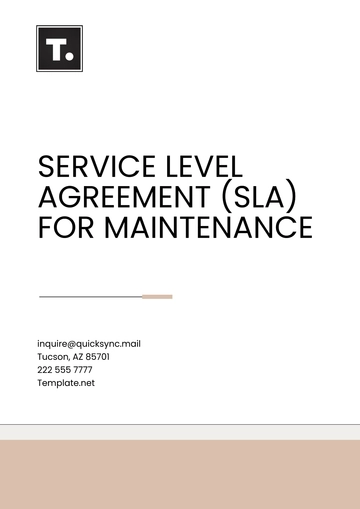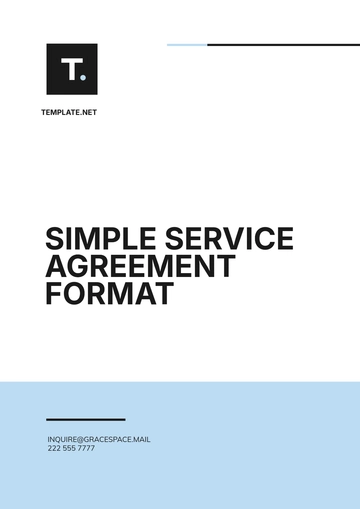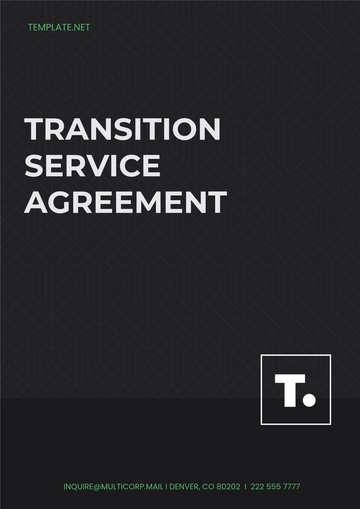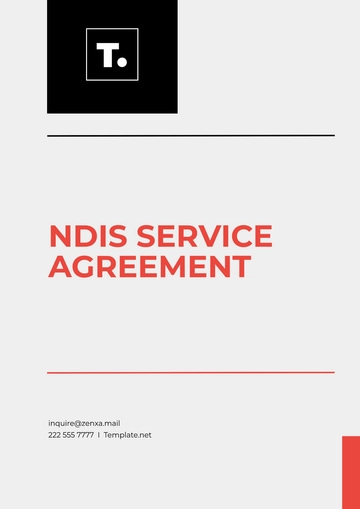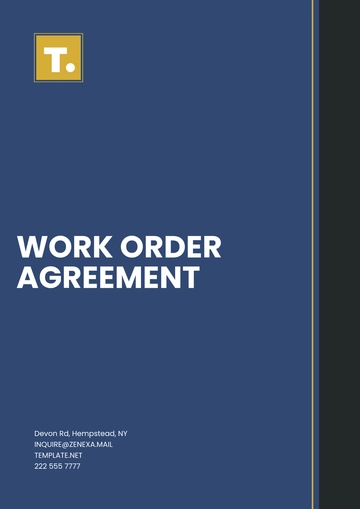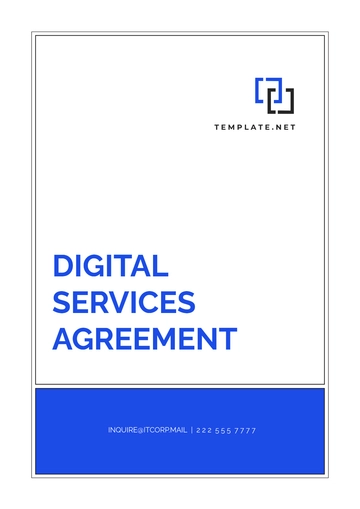Free Service Level Agreement (SLA)

This Service Level Agreement (hereinafter referred to as the "Agreement") is entered into by and between [Your Company Name] with a registered address at [Your Company Address], registration number [Your Company Number], represented by [Your Name], email address [Your Company Email], (hereinafter referred to as "Party A") and [Second Party Name], with a registered address at [Second Party Address], registration number [Second Party Number], represented by [Second Party Representative], email address [Second Party Representative Email] (hereinafter referred to as "Party B") (collectively referred to as the "Parties").
1. SCOPE OF SERVICES
This Agreement defines Party A's specific service responsibilities to Party B. These duties are extensive and adjustable to suit changing circumstances for mutual objectives. It gives both parties a clear understanding of the services to be performed. The adaptable and comprehensive service scope accommodates changes in objectives and external impacts on deliverables. This clear definition of service parameters minimizes potential misunderstandings, fostering a smooth working relationship and realizing mutual benefits in the Agreement.
2. PERFORMANCE MEASUREMENT
The Parties involved in this Agreement have mutually agreed to use a specific method of evaluating the performance of the services that are to be provided. This method involves using the performance standards that will be defined and set out in the parameters of this Agreement. Both Parties also acknowledge that these performance levels must be in alignment with the business requirements that each Party has. This allows for a fair and balanced evaluation of the services provided and ensures that all performed activities serve the business interests of both Parties.
2.1 Establishing Clear Metrics: Both Parties will collaborate to define specific performance metrics, ensuring they accurately reflect the objectives and needs outlined in the Agreement. These metrics will serve as benchmarks to evaluate the effectiveness of the services provided.
2.2 Regular Monitoring and Evaluation: A systematic process will be implemented to monitor and evaluate performance against the established metrics at regular intervals. This ongoing assessment will enable proactive adjustments to ensure alignment with evolving business requirements and maintain service quality.
2.3 Continuous Improvement Initiatives: Both Parties commit to fostering a culture of continuous improvement, utilizing performance data and feedback to identify areas for enhancement. Through collaborative efforts, they will implement strategies to optimize service delivery and achieve mutually beneficial outcomes.
3. SERVICE LEVELS
Party A commits and gives its assurance that it will fulfill the required level of services that have been mutually agreed upon. This commitment and the specific level of services expected will be clearly outlined and detailed within the context of this Agreement. Furthermore, Party A acutely recognizes and acknowledges that should they fail to meet the agreed levels of service, such failure can have potential detrimental or negative implications on the operations of Party B.
3.1 Agreed Standards: Party A commits to fulfilling the service levels specified in the Agreement, recognizing that any deviations could disrupt Party B's operations and undermine their trust in the partnership.
3.2 Operational Impact: Failure to meet the agreed service levels may lead to operational inefficiencies for Party B, potentially resulting in financial losses or damage to its reputation.
3.3 Mutual Understanding: Both parties recognize the critical importance of adhering to the established service levels to maintain a mutually beneficial and sustainable business relationship.
3.4 Risk Management: Adhering to the agreed-upon service levels serves as a proactive measure to mitigate risks and ensure the smooth functioning of operations for both Party A and Party B.
3.5 Continuous Improvement: Regular monitoring and evaluation of service level performance are essential for identifying areas of improvement and maintaining the quality standards expected by Party B.
4. RESOLVING SERVICE-RELATED ISSUES
When service-related issues occur, swift and cooperative action from both Party A and Party B is essential to uphold their agreement. Party A is responsible for promptly addressing problems, while Party B identifies and reports service failures. This well-defined role division assures an organized approach to issue resolution. Effective communication and client satisfaction are prioritized, with Party A actively resolving challenges and Party B ensuring transparency through vigilant performance monitoring. This cooperative and committed approach establishes a trustworthy, reliable partnership.
5. TERMS OF PAYMENT
The Parties have come to a mutual agreement in which they have decided that Party B will be responsible for providing financial compensation to Party A. This compensation is for the services provided by Party A. The specific terms and conditions related to this financial compensation will be thoroughly detailed and described in the Service Level Agreement. It is understood and accepted by both parties that this agreement serves as the guiding document for addressing financial matters between them.
5.1 Financial Compensation Agreement: Party B commits to providing financial compensation to Party A for the services rendered, as detailed in the Service Level Agreement (SLA).
5.2 Payment Terms: The specifics of the payment arrangement between Party A and Party B will be outlined in the SLA, ensuring clarity and mutual understanding.
5.3 Agreed Compensation: Both parties acknowledge and agree upon the compensation structure delineated within the SLA, ensuring transparency and accountability in financial transactions.
6. TERM AND TERMINATION
This Agreement shall start its term and be in full effect starting from the effective date. The Agreement will remain operational until it is detached, with either Party retaining the right to terminate it at their discretion. Furthermore, the conditions and terms under which the termination of this Agreement can occur are meticulously detailed within the body of the Agreement itself.
6.1 Commencement Date: The Agreement's term begins on the effective date specified, marking the initiation of the contractual obligations for both parties involved.
6.2 Continuation Clause: Until formally terminated by either party, the Agreement remains in force, ensuring the sustained commitment to its terms and conditions over the specified period.
6.3 Termination Provisions: Clear guidelines regarding termination are outlined within the Agreement, delineating the circumstances and procedures under which either party may choose to end the contractual relationship.
6.4 Mutual Agreement: Termination may occur through mutual agreement, enabling both parties to dissolve the contract amicably, should circumstances necessitate such action.
6.5 Legal Implications: Understanding the legal implications of termination is crucial, as it ensures compliance with contractual obligations and protects the interests of both parties involved in the Agreement.
IN WITNESS WHEREOF, the Parties hereto have executed this Agreement as of [EFFECTIVE DATE].

[PARTY A'S NAME]
[DATE SIGNED]

[PARTY B'S NAME]
[DATE SIGNED]
- 100% Customizable, free editor
- Access 1 Million+ Templates, photo’s & graphics
- Download or share as a template
- Click and replace photos, graphics, text, backgrounds
- Resize, crop, AI write & more
- Access advanced editor
Enhance and Discover the Agreement Between Two Parties Template from Template.net. Crafted for ease, it's fully editable and customizable, ensuring seamless adaptation to your specific needs. Utilize our AI Editor Tool to effortlessly personalize this essential document, guaranteeing clarity and precision in outlining service expectations. Elevate your agreements effortlessly with Template.net!
You may also like
- Lease Agreement
- Non Compete Agreement
- Rental Agreement
- Prenuptial Agreement
- Non Disclosure Agreement
- Operating Agreement
- Hold Harmless Agreement
- LLC Operating Agreement
- Arbitration Agreement
- Purchase Agreement
- Residential Lease Agreement
- Executive Agreement
- Confidentiality Agreement
- Contractor Agreement
- Partnership Agreement
- Postnuptial Agreement
- Collective Bargaining Agreement
- Loan Agreement
- Roommate Agreement
- Commercial Lease Agreement
- Separation Agreement
- Cohabitation Agreement
- Room Rental Agreement
- Child Custody Agreement
- Employee Agreement
- License Agreements
- Settlement Agreement
- Joint Venture Agreement
- Indemnity Agreement
- Subordination Agreement
- Sales Agreement
- Agreements Between Two Parties
- Business Agreement
- Real Estate Agreement
- HR Agreement
- Service Agreement
- Property Agreement
- Agreement Letter
- Restaurant Agreement
- Construction Agreement
- Finance Agreement
- Marketing Agreement
- Payment Agreement
- Investment Agreement
- Management Agreement
- Nonprofit Agreement
- Software Agreement
- Startup Agreement
- Agency Agreement
- Copyright Agreement
- Collaboration Agreement
- Reseller Agreement
- Car Rental Agreement
- Cleaning Services Agreement
- Consultant Agreement
- Deed Agreement
- Car Agreement
- Equipment Agreement
- Shares Agreement
- Data Sharing Agreement
- Advertising Agreement
- School Agreement
- Franchise Agreement
- Event Agreement
- Travel Agency Agreement
- Vehicle Agreement
- Board Resolution Agreement
- Land Agreement
- Binding Agreement
- Tenancy Agreement
- Exclusive Agreement
- Development Agreement
- Assignment Agreement
- Design Agreement
- Equity Agreement
- Mortgage Agreement
- Purchase and Sale Agreement
- Shareholder Agreement
- Vendor Agreement
- Royalty Agreement
- Vehicle Lease Agreement
- Hotel Agreement
- Tenant Agreement
- Artist Agreement
- Commission Agreement
- Consignment Agreement
- Debt Agreement
- Recruitment Agreement
- Training Agreement
- Transfer Agreement
- Apprenticeship Agreement
- IT and Software Agreement
- Referral Agreement
- Resolution Agreement
- Waiver Agreement
- Consent Agreement
- Partner Agreement
- Social Media Agreement
- Customer Agreement
- Credit Agreement
- Supply Agreement
- Agent Agreement
- Brand Agreement
- Law Firm Agreement
- Maintenance Agreement
- Mutual Agreement
- Retail Agreement
- Deposit Agreement
- Land Purchase Agreement
- Nursing Home Agreement
- Supplier Agreement
- Buy Sell Agreement
- Child Support Agreement
- Landlord Agreement
- Payment Plan Agreement
- Release Agreement
- Research Agreement
- Sponsorship Agreement
- Buyout Agreement
- Equipment Rental Agreement
- Farm Agreement
- Manufacturing Agreement
- Strategic Agreement
- Termination of Lease Agreement
- Compliance Agreement
- Family Agreement
- Interior Design Agreement
- Ownership Agreement
- Residential Lease Agreement
- Retainer Agreement
- Trade Agreement
- University Agreement
- Broker Agreement
- Dissolution Agreement
- Funding Agreement
- Hosting Agreement
- Investor Agreement
- Memorandum of Agreement
- Advisory Agreement
- Affiliate Agreement
- Freelancer Agreement
- Grant Agreement
- Master Service Agreement
- Parking Agreement
- Subscription Agreement
- Trust Agreement
- Cancellation Agreement
- Horse Agreement
- Influencer Agreement
- Membership Agreement
- Vacation Rental Agreement
- Wholesale Agreement
- Author Agreement
- Distributor Agreement
- Exchange Agreement
- Food Agreement
- Guarantee Agreement
- Installment Agreement
- Internship Agreement
- Music Agreement
- Severance Agreement
- Software Development Agreement
- Storage Agreement
- Facility Agreement
- Intercompany Agreement
- Lending Agreement
- Lodger Agreement
- Outsourcing Services Agreement
- Usage Agreement
- Assurance Agreement
- Photography Agreement
- Profit Sharing Agreement
- Relationship Agreement
- Rent To Own Agreement
- Repayment Agreement
- Volunteer Agreement
- Co Parenting Agreement
- HVAC Agreement
- Lawn Care Agreement
- SAAS Agreement
- Work from Home Agreement
- Coaching Agreement
- Protection Agreement
- Security Agreement
- Repair Agreement
- Agreements License





